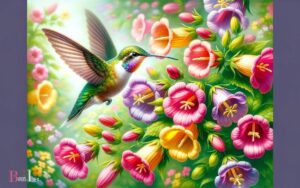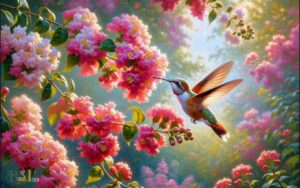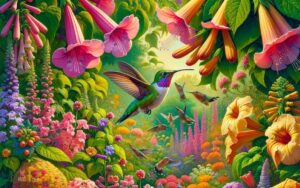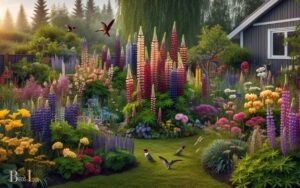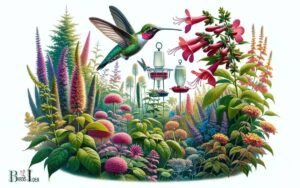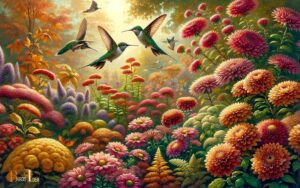Does Autumn Sage Attract Hummingbirds? Yes!
Yes, Autumn Sage (Salvia greggii) is known for its ability to attract hummingbirds. This perennial shrub produces vibrant flowers that are rich in nectar, making it an excellent food source for these tiny birds.
Autumn Sage is a popular plant among gardeners who want to encourage hummingbird visits. Its tubular flowers are perfectly shaped for the long beaks of hummingbirds, allowing them to feed efficiently.
Moreover, its extended blooming period, from spring to frost, provides a consistent source of nectar throughout the seasons.
Autumn Sage is available in various colors, including red, pink, purple, and coral, all of which are attractive to hummingbirds.
Attracting hummingbirds to your garden is easy with Autumn Sage, a nectar-rich plant that boasts colorful and tubular blooms for much of the year.
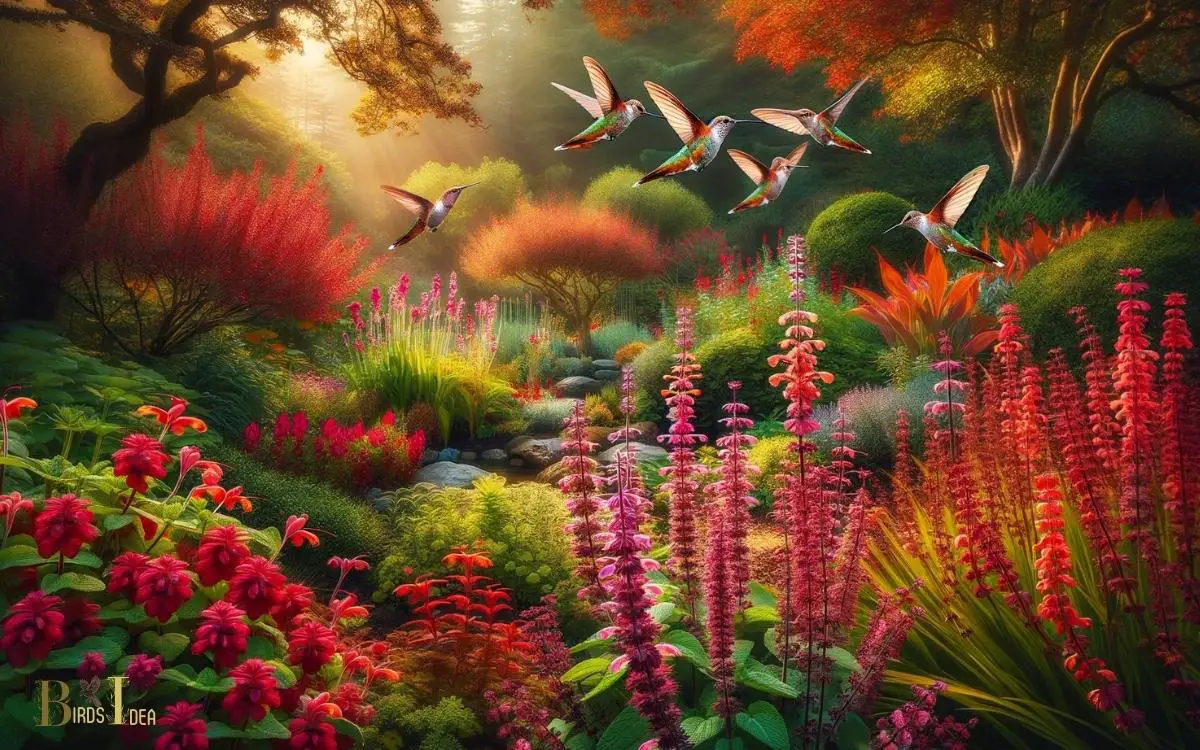
Key Takeaway
Characteristics of Autumn Sage
Autumn sage, also known as Salvia greggii, is a small, perennial shrub that typically reaches a height of 18 to 24 inches.
Its slender, aromatic leaves are a silvery-green color and release a pleasant scent when crushed.
The plant produces an abundance of tubular flowers that come in a variety of colors, including red, pink, and orange.
These flowers are a magnet for pollinators, especially hummingbirds, due to their nectar-rich composition.
The plant’s compact size and attractive foliage make it a popular choice for garden borders, rock gardens, and containers.
Its ability to thrive in a variety of soil types and its low maintenance requirements make it an excellent addition to any garden.
Hummingbird Attraction Mechanism
Autumn sage (Salvia greggii) is known for its nectar-rich floral blooms, particularly its bright red tubular flowers that are particularly attractive to hummingbirds.
These flowers provide a high-energy food source for hummingbirds due to their high sugar content, making them an important resource for the birds during migration and breeding seasons.
The shape and color of the blooms, combined with the abundance of nectar, make autumn sage a key player in attracting and sustaining hummingbird populations.
Nectar-Rich Floral Blooms
How does the Autumn Sage plant attract hummingbirds with its nectar-rich floral blooms? The answer lies in the intricate design of its flowers.
- Tubular Shape: The flowers’ elongated, tubular shape is perfectly suited for the long, slender beaks of hummingbirds, allowing them to easily reach the nectar deep within the bloom.
- Vibrant Colors: The vibrant red, pink, or purple hues of the flowers act as a visual beacon, catching the attention of hummingbirds from a distance.
- Abundant Nectar: The abundant nectar production within the blooms serves as a rich fuel source for the high-energy needs of hummingbirds.
- Sweet Aroma: The sweet, enticing aroma emitted by the flowers further entices hummingbirds to visit and feed on the nectar.
These features collectively make the nectar-rich floral blooms of Autumn Sage highly attractive to hummingbirds.
The next section will delve into the significance of the plant’s bright red tubular flowers in hummingbird attraction.
Bright Red Tubular Flowers
The bright red tubular flowers of the Autumn Sage plant serve as a primary mechanism for attracting hummingbirds.
These flowers are specially adapted to appeal to hummingbirds, with their vibrant red color and elongated shape.
The color red is known to be highly attractive to hummingbirds, as they have a strong affinity for bright, bold hues.
The tubular structure of the flowers is also significant, as it perfectly complements the hummingbird’s long, slender bill.
This design allows the birds to easily access the nectar concealed within the depths of the flower.
Furthermore, the abundance of these tubular blooms on the Autumn Sage plant provides a sustainable food source for hummingbirds, ensuring their continued return to the plant for nourishment.
Bloom Colors and Patterns
Bloom colors and patterns play a significant role in attracting hummingbirds to Autumn Sage. The vibrant hues and unique patterns of the flowers are key to catching the attention of these remarkable birds.
- The rich, deep red blooms with their tubular shape are particularly appealing to hummingbirds, standing out against the green foliage.
- The contrasting white or pink throats of the flowers create a visually striking effect, further enhancing their allure to hummingbirds.
- Some varieties of Autumn Sage boast bi-colored blooms, with petals that transition from one shade to another, adding an extra element of visual interest.
- The intricate patterns and markings on the petals provide guidance to the hummingbirds, directing them towards the nectar source within the flowers.
These captivating colors and patterns make Autumn Sage an irresistible draw for hummingbirds seeking out their next nectar fix.
Ideal Growing Conditions
To thrive, Autumn Sage requires well-drained soil and full sunlight. This perennial plant is native to the rocky slopes and woodlands of Texas, making it well-suited for hot and dry conditions.
It is important to note that Autumn Sage is not tolerant of wet or poorly drained soils, as this can lead to root rot.
The table below outlines the ideal growing conditions for Autumn Sage to thrive.
| Ideal Growing Conditions | Description |
|---|---|
| Soil | Well-drained |
| Sunlight | Full sun |
| Water | Low to moderate levels |
| Temperature | Thrives in heat |
| Humidity | Tolerates dry climates |
These conditions mimic the plant’s natural habitat, ensuring its health and ability to attract hummingbirds.
Tips for Attracting Hummingbirds
Hummingbirds are attracted to a variety of flowers, including the vibrant blooms of the autumn sage.
Planting a diverse array of nectar-rich flowers, such as bee balm and trumpet vine, can entice these tiny birds to visit a garden.
Additionally, providing sugar water feeders can supplement their natural nectar sources and create a welcoming environment for hummingbirds.
Planting Hummingbird-Friendly Flowers
Autumn sage can effectively draw in hummingbirds when planted alongside other nectar-producing flowers.
To create an inviting environment for these delightful creatures, consider incorporating the following flowers in your garden:
- Trumpet Vine: This vibrant flowering vine produces copious amounts of nectar and provides a stunning visual appeal.
- Bee Balm: With its striking red, pink, or purple blooms, bee balm is a favorite of hummingbirds due to its abundant nectar.
- Salvia: The tubular flowers of salvia are rich in nectar and come in a variety of colors, making them a versatile choice for attracting hummingbirds.
- Lupine: The tall spikes of lupine flowers offer a generous supply of nectar, attracting hummingbirds with their colorful display.
These flowers, when strategically planted alongside autumn sage, can create an irresistible haven for hummingbirds in your garden.
Providing Sugar Water Feeders
In attracting hummingbirds, consider providing sugar water feeders as a supplement to natural nectar sources in the garden.
When setting up sugar water feeders, it’s essential to use a solution of four parts water to one part white granulated sugar.
Boiling the water before adding sugar helps to dissolve it thoroughly and prevents fermentation.
Position the feeders in shaded areas to inhibit the growth of mold and bacteria. It’s crucial to clean and refill the feeders every two to three days, especially in warmer weather, to maintain the freshness of the nectar.
Additionally, placing multiple feeders in different locations around the garden can help reduce competition and aggression among hummingbirds.
By following these tips, enthusiasts are more likely to attract and support a thriving population of hummingbirds in their outdoor spaces.
Other Bird Species Attracted
The Autumn Sage is known for attracting not only hummingbirds but also for drawing in other bird species.
When observing this flowering plant, one can often see a variety of birds enjoying its nectar and creating a lively scene in the garden.
Some of the other bird species attracted to Autumn Sage include:
- Songbirds: These small, melodious birds are frequently seen flitting around the sage, adding cheerful chirps to the surroundings.
- Butterflies: While not a bird species, the presence of butterflies adds to the vibrant display around the Autumn Sage, as they are also attracted to its nectar.
- Warblers: These colorful, energetic birds are occasionally spotted darting in and out of the sage, contributing to the lively atmosphere.
- Finches: Their bright plumage and lively presence make them a delightful addition to the bird community drawn to the Autumn Sage.
Autumn Sage Maintenance and Care
Proper maintenance and care of Autumn Sage, such as regular pruning and well-drained soil, are essential for ensuring its healthy growth and prolific blooming.
Autumn Sage is a resilient and low-maintenance plant, but it still requires some attention to thrive.
The following table outlines key maintenance and care practices for Autumn Sage:
| Maintenance and Care | Description |
|---|---|
| Pruning | Trim back the plant in late winter or early spring to encourage new growth and maintain its shape. |
| Soil | Plant Autumn Sage in well-drained soil to prevent waterlogging, which can lead to root rot. |
| Watering | Water the plant deeply but infrequently, allowing the soil to dry out between waterings to promote strong root development. |
Conclusion
Autumn sage is a remarkable plant that serves as a magnet for hummingbirds due to its vibrant blooms and nectar production.
Like a beacon in the garden, it attracts these tiny, iridescent birds with its irresistible colors and sweet nectar.
With the right care and conditions, autumn sage can bring a delightful flurry of activity to any garden, making it a must-have for bird enthusiasts.

